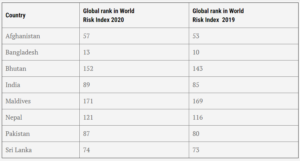In news : India ranked 89th among the 181 countries on World Risk Index (WRI) 2020
About the index
- The World Risk Index developed by the United Nations University Institute for Environment and Human Education(UNU-EHS) describes the disaster risk for various countries and regions.
- UNU-EHS: It is the academic arm of the United Nations and acts as a global think tank
- Others who have been involved are: Bundnis Entwicklung Hilft and the University of Stuttgart in Germany.
- The WRI is calculated on a country-by-country basis, through the multiplication of exposure and vulnerability.
- The main focus of the report is the threat from, or exposure to key natural hazards and the rise in sea level caused by climate change, as well as social vulnerability in the form of the population’s susceptibility and their capacity for coping and adaptation.
- The World Risk Index shows the level of risk for each country and provides a global overview.
- It underscores that risks are heavily determined by the susceptibility and the coping as well as the adaptive capacity of a society.
- The WRI, released annually since 2011, indicates which countries are in the greatest need to strengthen measures for coping with and adapting to extreme natural events.
Key findings
Asia:
- India and other south Asian nations did improve their ranking marginally in the World Risk Index during the course of a year.
- Bhutan improved its ranking the most, followed by Pakistan.
- However, all south Asian countries had slipped on their ability to adapt to the reality of climate emergency, a comparison with the World Risk Index 2019 showed.
- All south Asian countries fared poorly in the 2020 index (as compared to 2019) on strengthening their abilities to prepare and adapt to extreme events

Africa:
Oceania and small Islands:
- The index showed that Oceania was the continent most at risk, followed by Africa and the Americas.
- Vanuatu was the country with the highest disaster risk worldwide. It was followed by Tonga and Dominica.
- Small island states, especially in the South Pacific and the Caribbean, were disproportionately represented among high-risk countries, due to their high exposure to extreme natural events. These also included countries at risk from the rise in sea level as a result of global warming.
- The small island states had limited financial resources and had made small contributions to climate change, but were affected the most by its consequences.
- Qatar had the lowest risk (0.31) according to the global index.
Africa:
- It identified Africa as a hotspot of vulnerability.
- More than two-thirds of the most vulnerable countries in the world were located on the continent.
- The Central African Republic was the most vulnerable country, followed by Chad, the Democratic Republic of Congo, Niger and Guinea-Bissau.
India’s status
- India was ‘poorly prepared’ to deal with ‘climate reality’, due to which it was more vulnerable to extreme natural disasters, according to the World Risk Index (WRI) 2020.
- India ranked 89th among 181 countries on the WRI 2020. The country was fourth-most-at- risk in south Asia on the index, after Bangladesh, Afghanistan and Pakistan.
- Sri Lanka, Bhutan and the Maldives fared better than India in their abilities to cope with extreme disasters, the report said.
- India also lagged behind these three neighbours in terms of lack of adaptive capacities or the preparedness to deal with extreme events.
- India also slipped on strengthening adaptive capacities. This is worrying given that the country’s first comprehensive climate change assessment report has set alarm bells ringing about the impacts of ‘climate crisis’
















